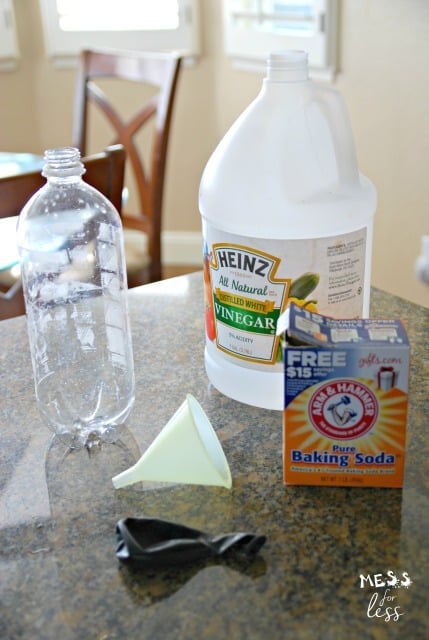Most kids have a natural interest in science and how the world around them works. Doing science experiments at home can sound intimidating, but luckily you don't have to be a scientist to share some fun science activities with your kids. Recently, we did this Self Inflating Balloon Experiment and it was so much fun to watch the expressions on my children's faces as the magic happened! After you enjoy this activity, don't put those balloons away. Use them for some fun learning activities using balloons such as How Many Balloons Can Lift a Bag and Make a Balloon Zipline.

Jump to:
Please supervise your children during all activities.
My kids were a little skeptical when I told they we were going to be inflating a balloon without blowing into it or using helium. Make no mistake - even though this can be done with kids, it is a true science experiment.
Why this Self Inflating Balloon Experiment is great for kids
- They get the learn the outcome of a simple chemical reaction
- They will learn about the properties of substances
- This classic science experiment will pique their curiosity
- It takes just a few household staples for this fun science lesson
Supplies needed
- latex balloon
- 1 liter plastic bottle
- funnel
- 1 teaspoon baking soda
- 3 tablespoons of vinegar

How to make a self inflating balloon
Clean a 1 liter bottle and let dry. Using a funnel, add 1 teaspoon of baking soda to the bottle.

Place the small end of the funnel into the opening of the balloon. Hold carefully and pour the vinegar into the balloon.

Carefully stretch out the open end of the balloon and place over the mouth of the bottle, while leaving the rest of the balloon hanging. This part was a little tricky for my kids, so I helped. Make sure to get a good seal. Older kids can probably do this part themselves, but younger kids will need assistance.
Hold on to the balloon at the point where it is attached to the bottle. Lift up the rest of the balloon to pour the vinegar inside the bottle, while continuing to hold the balloon at the seal. When the vinegar interacts with the baking soda on the bottom of the bottom, it will start to bubble and make the balloon blow up.

How did this happen? When the vinegar and baking soda mix together, carbon dioxide gas is produced and this gas causes the balloon to inflate. The acid-base reaction causes the balloon to inflate.
You can ask your kids to form a hypothesis before performing this vinegar balloon experiment.
This self inflating balloon experiment takes just a few minutes to do and uses lots of supplies you probably already have at home. Learning has never been so much fun!

Frequently asked questions
No. You can even use a small water bottle if that is all you have on hand.
No, the reaction is contained in the bottle, making this perfect to do with kids.
Does your child love science?
Easy experiments and different chemical reactions are so much fun for kids and they are not intimidating for parents. If you are looking for some more easy experiments, the Spangler Science Club delivers amazing hands-on science to your door every month. Join Today! These make great gifts for budding scientists. Each month, your child will receive the most amazing science experiments delivered to your door.






Leave a Reply